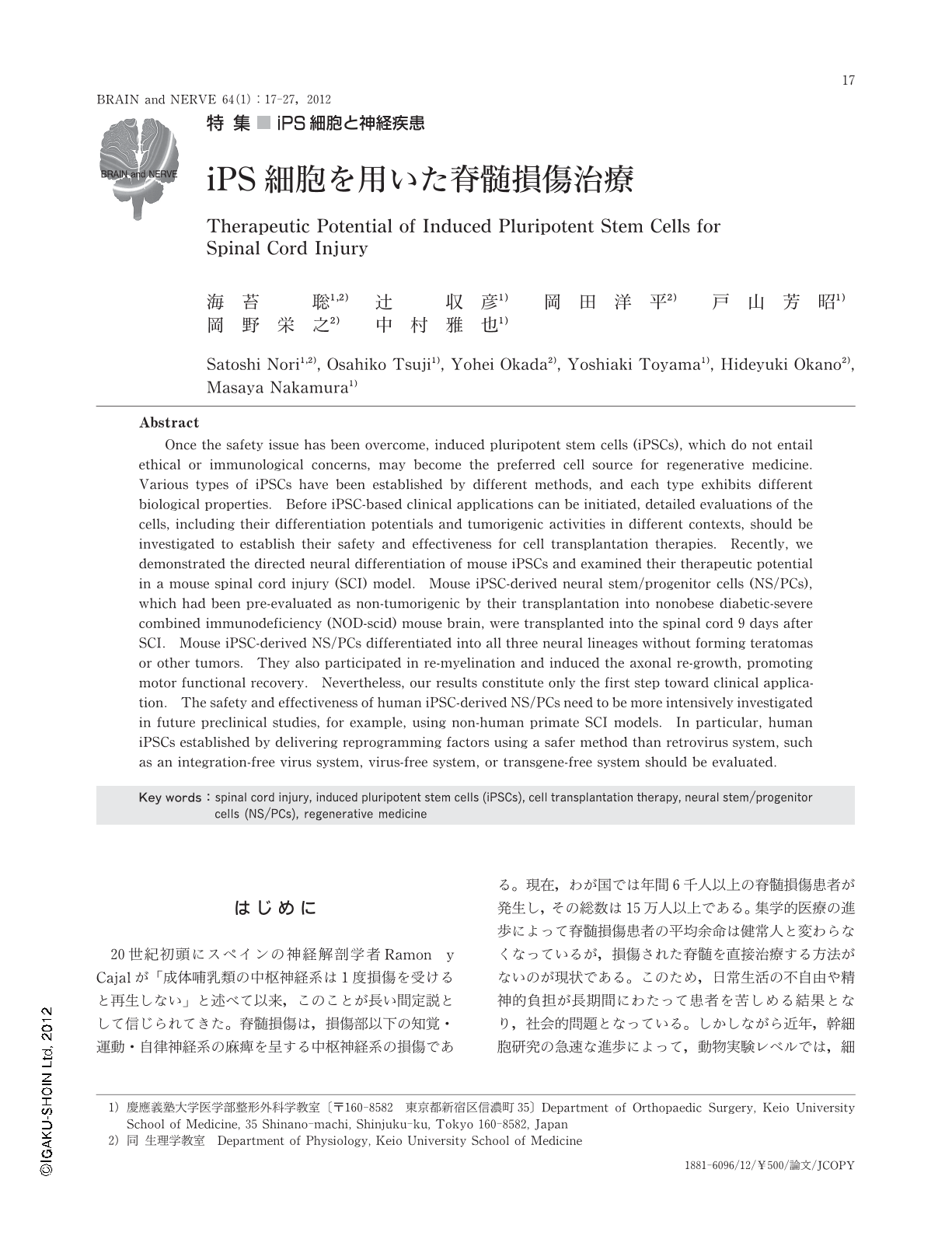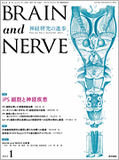Japanese
English
- 有料閲覧
- Abstract 文献概要
- 1ページ目 Look Inside
- 参考文献 Reference
はじめに
20世紀初頭にスペインの神経解剖学者Ramon y Cajalが「成体哺乳類の中枢神経系は1度損傷を受けると再生しない」と述べて以来,このことが長い間定説として信じられてきた。脊髄損傷は,損傷部以下の知覚・運動・自律神経系の麻痺を呈する中枢神経系の損傷である。現在,わが国では年間6千人以上の脊髄損傷患者が発生し,その総数は15万人以上である。集学的医療の進歩によって脊髄損傷患者の平均余命は健常人と変わらなくなっているが,損傷された脊髄を直接治療する方法がないのが現状である。このため,日常生活の不自由や精神的負担が長期間にわたって患者を苦しめる結果となり,社会的問題となっている。しかしながら近年,幹細胞研究の急速な進歩によって,動物実験レベルでは,細胞移植をはじめ,損傷脊髄の修復が得られる治療法が多数報告されるようになった。基礎研究で得られた結果を臨床の現場で応用できれば,脊髄損傷に対して新たな治療法を確立することも夢ではないと考えられる。
細胞移植は古くから注目を集めており,1980年代にスウェーデンLund大学のLindvallのグループ1)が,パーキンソン病患者の脳へ胎児中脳を移植し,機能の回復が得られることを報告した。その後,ラット脊髄損傷に対しても,ラット胎仔脊髄移植の有効性が示された2,3)。これによって,損傷した脊髄でも微小環境が整えば再生することが示され「中枢神経系は1度損傷を受けると再生しない」という通説が覆された。
脊髄損傷における再生医療の戦略は,神経栄養因子や軸索伸展阻害因子の阻害剤4)などを組み合わせた細胞移植療法以外の治療法と神経幹細胞・ES細胞・iPS細胞などを用いた細胞移植療法の2つのアプローチに大別される5)。これらの方法を組み合わせた治療を行うことで,損傷された神経組織を再生し機能を回復させることができれば,脊髄損傷治療に新たな可能性が開けてくるものと確信している。本稿では,われわれがこれまで行ってきた神経幹細胞・ES細胞を用いた細胞移植研究の現状に触れながら,現在日本において再生医療分野で最も注目されている,「iPS細胞を用いた脊髄損傷治療の現状と今後の展望」について概説する。
Abstract
Once the safety issue has been overcome,induced pluripotent stem cells (iPSCs),which do not entail ethical or immunological concerns,may become the preferred cell source for regenerative medicine. Various types of iPSCs have been established by different methods,and each type exhibits different biological properties. Before iPSC-based clinical applications can be initiated,detailed evaluations of the cells,including their differentiation potentials and tumorigenic activities in different contexts,should be investigated to establish their safety and effectiveness for cell transplantation therapies. Recently,we demonstrated the directed neural differentiation of mouse iPSCs and examined their therapeutic potential in a mouse spinal cord injury (SCI) model. Mouse iPSC-derived neural stem/progenitor cells (NS/PCs),which had been pre-evaluated as non-tumorigenic by their transplantation into nonobese diabetic-severe combined immunodeficiency (NOD-scid) mouse brain,were transplanted into the spinal cord 9 days after SCI. Mouse iPSC-derived NS/PCs differentiated into all three neural lineages without forming teratomas or other tumors. They also participated in re-myelination and induced the axonal re-growth,promoting motor functional recovery. Nevertheless,our results constitute only the first step toward clinical application. The safety and effectiveness of human iPSC-derived NS/PCs need to be more intensively investigated in future preclinical studies,for example,using non-human primate SCI models. In particular,human iPSCs established by delivering reprogramming factors using a safer method than retrovirus system,such as an integration-free virus system,virus-free system,or transgene-free system should be evaluated.

Copyright © 2012, Igaku-Shoin Ltd. All rights reserved.


